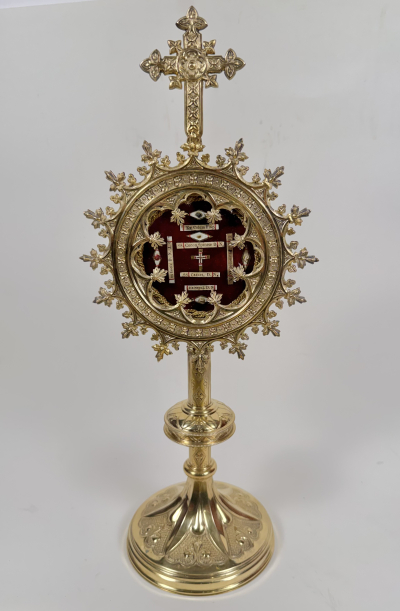The True Cross is the name for physical remnants which, by the Church tradition, are believed to be from the cross upon which Jesus was crucified. Empress Helena, the mother of Constantine, the first Christian Emperor of Rome, traveled to the Holy Land in 326–28, where she discovered the hiding place of three crosses that were believed to be used at the crucifixion of Jesus and of two thieves, St. Dismas and Gestas, executed with him, and a miracle revealed which of the three was the True Cross. Fragments of the Cross were broken up, and the pieces were widely distributed; in 348, in one of his Catecheses, Cyril of Jerusalem remarked that the "whole earth is full of the relics of the Cross of Christ." Most of the very small relics of the True Cross in Europe came from Constantinople after the city was captured and sacked in 1204 during the Fourth Crusade. They were carved up by the present bishops and divided with other very precious relics among the knights; who, after their return to the homeland, donated them to churches and monasteries.
According to the New Testament, a woven Crown of Thorns was placed on the head of Jesus during the events leading up to his crucifixion. It was one of the instruments of the Passion, employed by Jesus' captors both to cause him pain and to mock his claim of authority. It is mentioned in the gospels of Matthew (Matthew 27:29), Mark (Mark 15:17) and John (John 19:2, 19:5), and is often alluded to by the early Church Fathers, such as Clement of Alexandria, Origen and others, along with being referenced in the apocryphal Gospel of Peter. Since at least around the year 400 AD, a relic of the Crown of Thorns has been venerated. In 1238, the Latin Emperor Baldwin II of Constantinople yielded the relic to French King Louis IX.
Of the many relics associated with the Passion of Jesus, the Column of the Flagellation (or the Scourging Post) is one of the more physically imposing. Certainly, the significance of the Crown of Thorns, the Holy Lance, Holy Nails, pieces of the True Cross, and other first-class relics of the Passion cannot be understated. However, the sheer size of the Column of the Flagellation lends it a physical presence unmatched by other relics of the Passion. Saint Mark‘s gospel states, “So Pilate, wishing to satisfy the crowd, released for them Barabbas; and having scourged Jesus, he delivered him to be crucified.” The Column of the Flagellation is said to have been discovered by Saint Helena during a visit to Jerusalem in the 4th century and was eventually transported to Italy, and in the early 13th century to be installed in the Church of Saint Praxedes (Santa Prassede) in Rome by the appropriately named Cardinal Giovanni Colonna. Today, the Column of the Flagellation is kept in a small side chapel in the Church of Saint Praxedes, displayed in a glass reliquary.
The Grotto of the Nativity is located inside of the Church of the Nativity, a basilica located in Bethlehem. Over the centuries, the surrounding compound has been expanded, and today it comprises three different monasteries: one Catholic, one Armenian Apostolic, and one Greek Orthodox. The grotto holds a prominent religious significance to Christians as the birthplace of Jesus and is the oldest site continuously used as a place of worship in Christianity. The Grotto of the Nativity is an underground space which forms the crypt of the Church of the Nativity. It is situated underneath its main altar, and it is normally accessed by two staircases on either side of the chancel. The grotto is part of a network of caves. Catholics are in charge of a section of the grotto known as the "Grotto of the Manger", marking the traditional site where Mary laid the newborn baby in the manger.










 Поменять язык на русский
Поменять язык на русский 